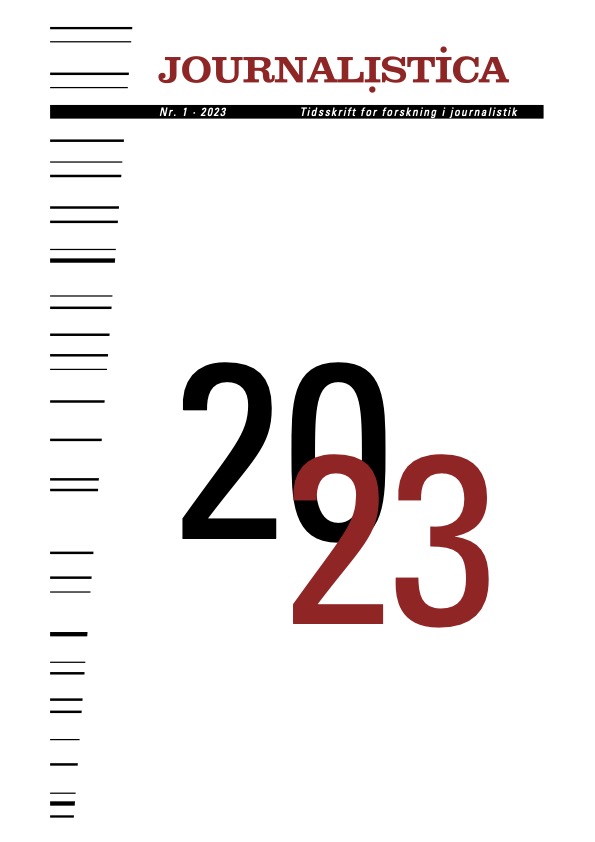Skiftande berättarperspektiv och självkritisk reporter komplicerar bilden
Budskap och berättarteknik i tre svenska reportage-böcker om gängkriminalitet
DOI:
https://doi.org/10.7146/journalistica.v17i1.136679Keywords:
Reportage/narrative journalism, criminal gangs, narratology, media rhetoric, narrative compassion, narrative empathyAbstract
What messages do three recently published reportage books convey about Swedish gang criminality and what kinds of narrative techniques are used in the stories? With a mix of narratological and media rhetorical analysis methods, this article investigates how content and narrative form interact in Mammorna by Alexandra Pascalidou, Familjen by Johanna Bäckström Lerneby and Tills alla dör by Diamant Salihu. One conclusion is that varying narrative perspectives can counteract one-sidedness, while narrative compassion without parallel narrative empathy can block the reader’s ability to imagine the situation of the depicted people. Dramatized events may heighten the reader’s sense of being present in the story, while a reporter questioning his own authority encourages the reader to avoid simplistic conclusions. Finally, descriptions of persons and selections of facts in the three books contribute to different messages. The study illustrates that the genre of reportage/narrative journalism, thanks to its narrative form, has the potential to depict social problems in complex ways. This is especially true when the depiction is combined with solid factual research.
References
Aare, C. (2021). Reportaget som berättelse: En narratologisk undersök-ning av reportagegenren. Diss., Stockholms Universitet.
Baroni, R. (2014). Tellability. I The living handbook of narratology. https://www.lhn.uni-hamburg.de/node/30.html. https://doi.org/10.1515/9783110316469.836.
Booth, W. C. ([1961] 1983). The Rhetoric of Fiction. The University of Chicago Press. https://doi.org/10.7208/chicago/9780226065595.001.0001.
Broman, E. (2005). Narratologiska synvinkelmodeller: En kritisk genomgång. I S. Hellberg & G. Rossholm (red.), Att anlägga per-spektiv (s. 45–75). Brutus Östlings bokförlag Symposion.
Bäckström Lerneby. J. (2020). Familjen. Mondial.
Chatman, S. (1990). Coming to Terms: The Rhetoric of Narrative in Fiction and Film. Cornell University Press.
Cohn, D. ([1978] 1983). Transparent Minds: Narrative Modes for Pre-senting Consciousness in Fiction. Princeton University.
Esaiasson, P & Rothstein, B. (2020). Forskningen har missat de krimi-nella nätverken. Dagens Nyheter. 12 september.
Fludernik, M. (1996). Towards a ’Natural’ Narratology. Routledge. https://doi.org/10.1515/jlse.1996.25.2.97.
Hamburger, K. ([1957] 1973). The Logic of Literature, övers. Marilyn J. Rose. Indiana University Press.
Hultén, B. (2000). Journalistikanalys: En introduktion. Studentlittera-tur.
Keen, S. (2013). Narrative Empathy. I The Living Handbook of Narra-tology. https://doi.org/10.1515/9783110316469.521. https://www.lhn.uni-hamburg.de/node/42.html.
McHale. B. (1978). Free Indirect Discourse: A survey of Recent Ac-counts. A Journal for Descriptive Poetics and Theory of Literature, 3, 249–287.
Maier, S. R., Slovic, P. & Mayorca, M. (2017). Reader reaction to news of mass suffering: Assessing the influence of story form and emotional response. Journalism, 8, 1011–1029. https://doi.org/10.1177/1464884916663597.
Nermnan, B. (1973). Massmedieretorik. Awe/Gebers.
Pascalidou, A. ([2018] 2022). Mammorna. Mondial.
Rossholm, G. (2004). To Be And Not to Be: On Interpretation, Iconicity and Fiction. P. Lang.
Rossholm, G. (2005). Perspektiv och inlevelse i film och prosa. I S. Hellberg & G. Rossholm (red), Att anlägga perspektiv (s. 147–172). Brutus Östlings bokförlag Symposion.
Rønlev, R. og Hyldgaard, R. (2022). Ghostwriting: Jeg er en illusion skabt av ett spøgelse. I S. Moestrup, J. Gaarskjær & G. Luk (red), Hvad laver jeg her? En lærebog om at bruge sig selv i journalistik-ken (s. 117–136). Samfundslitteratur.
Salihu, D. (2021). Tills alla dör. Mondial.
Zunshine, L. (2006). Why We Read Fiction: Theory of Mind and the Nov-el. Ohio State University Press.
Downloads
Published
How to Cite
Issue
Section
License
Copyright (c) 2023 Cecilia Aare

This work is licensed under a Creative Commons Attribution 4.0 International License.
Forfattere, der publicerer deres værker via dette tidsskrift, accepterer følgende vilkår:
- Forfattere bevarer deres ophavsret og giver tidsskriftet ret til første publicering, samtidigt med at værket er omfattet af en Creative Commons Attribution-licens, der giver andre ret til at dele værket med en anerkendelse af værkets forfatter og første publicering i nærværende tidsskrift.
- Forfattere kan indgå flere separate kontraktlige aftaler om ikke-eksklusiv distribution af tidsskriftets publicerede version af værket (f.eks. sende det til et institutionslager eller udgive det i en bog), med en anerkendelse af værkets første publicering i nærværende tidsskrift.
- Forfattere har ret til og opfordres til at publicere deres værker online (f.eks. i institutionslagre eller på deres websted) forud for og under manuskriptprocessen, da dette kan føre til produktive udvekslinger, samt tidligere og større citater fra publicerede værker (se The Effect of Open Access).




